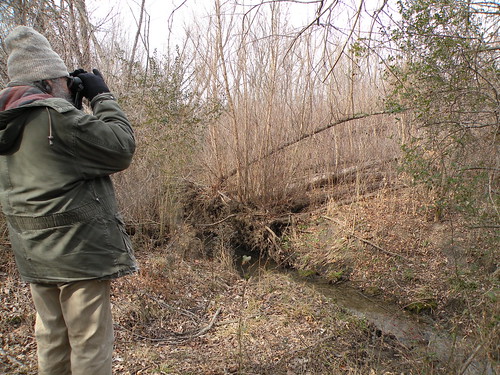Paraphrasing Edward Abbey, Seasonal wetland needs no defense, only more defenders. That was running through my mind after I had seen a fourth (possibly fifth) American Bittern yesterday at Woolsey Wet Prairie in Fayetteville. Woolsey had a prescribed burn on March 18. I walked the black yesterday evening.
Woolsey used to be just like tens of thousands of other low-lying former tallgrass prairie acres whose clay-rich soils retain so much water they are hard to plow. Unplowed or only plowed in the occasional dry year, they retain biotic aspects of tallgrass prairie. An anomaly, Woolsey is not ditched, drained, plowed, and covered with the endless ugly pursuit to turn every square inch into gold bullion. Unlike the lost tens of thousands, Woolsey functions to retain rain water and snow melt, protecting streams from flash floods. It does have migrating American Bitterns that eat what's in the shallows including bugs, fish, even snakes and small mammals, and terrestrial prairie crayfish whose burrows are much in evidence after the burn.
The wetland cells where I found bitterns didn't burn, of course, but higher areas did. Song, Swamp, and Savannah Sparrows were harvesting exposed seeds in the black. Swamp Sparrows have molted into the nesting season's bright plumage, reddish crown feathers contrasting blacken stubble.
Wetland mitigation cells function like shallow ponds. In these I found Blue-winged Teal (4), Green-winged Teal (2), Canada Goose (8), and one American Coot. Wilson's Snipe (15-20) flushed here and there. Chorus Frogs, Spring Peepers, and a choir of American Toads welcomed dusk.
It was a satisfying hour or so. I have never seen so many American Bitterns. It must be some kind of migration peak. But it is disturbing that we once held a fortune in functioning seasonal wetlands suitable for bitterns migrating through western Arkansas. That fortune has been thrown away. Today declining bittern populations face our bottleneck ? for what? You don't have to be a math whiz to see that greed driven sprawl contributes to this bird's population decline.
Too bad they don't make a bittern that eats ditching machines, drainage projects, plows, and real estate developers. And the next time someone calls you an environmental wacho because you prefer bitterns to mini-malls, tell them as I do that Noah loaded bitterns into the Ark. Who are we to say they don't belong here in our consumer paradise?
Again paraphrasing Abbey, American Bitterns need no defense, only more defenders.
--
JOSEPH C. NEAL in Fayetteville, Arkansas
Woolsey used to be just like tens of thousands of other low-lying former tallgrass prairie acres whose clay-rich soils retain so much water they are hard to plow. Unplowed or only plowed in the occasional dry year, they retain biotic aspects of tallgrass prairie. An anomaly, Woolsey is not ditched, drained, plowed, and covered with the endless ugly pursuit to turn every square inch into gold bullion. Unlike the lost tens of thousands, Woolsey functions to retain rain water and snow melt, protecting streams from flash floods. It does have migrating American Bitterns that eat what's in the shallows including bugs, fish, even snakes and small mammals, and terrestrial prairie crayfish whose burrows are much in evidence after the burn.
The wetland cells where I found bitterns didn't burn, of course, but higher areas did. Song, Swamp, and Savannah Sparrows were harvesting exposed seeds in the black. Swamp Sparrows have molted into the nesting season's bright plumage, reddish crown feathers contrasting blacken stubble.
Wetland mitigation cells function like shallow ponds. In these I found Blue-winged Teal (4), Green-winged Teal (2), Canada Goose (8), and one American Coot. Wilson's Snipe (15-20) flushed here and there. Chorus Frogs, Spring Peepers, and a choir of American Toads welcomed dusk.
It was a satisfying hour or so. I have never seen so many American Bitterns. It must be some kind of migration peak. But it is disturbing that we once held a fortune in functioning seasonal wetlands suitable for bitterns migrating through western Arkansas. That fortune has been thrown away. Today declining bittern populations face our bottleneck ? for what? You don't have to be a math whiz to see that greed driven sprawl contributes to this bird's population decline.
Too bad they don't make a bittern that eats ditching machines, drainage projects, plows, and real estate developers. And the next time someone calls you an environmental wacho because you prefer bitterns to mini-malls, tell them as I do that Noah loaded bitterns into the Ark. Who are we to say they don't belong here in our consumer paradise?
Again paraphrasing Abbey, American Bitterns need no defense, only more defenders.
--
JOSEPH C. NEAL in Fayetteville, Arkansas







